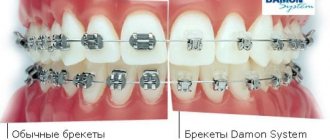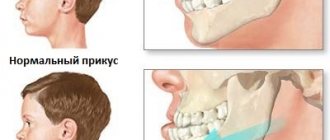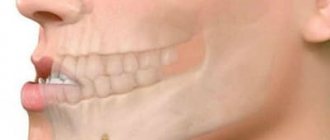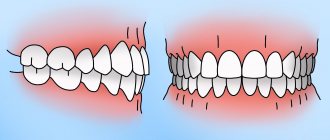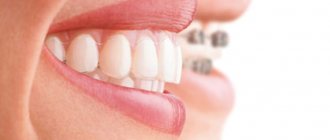The principle of operation of all braces is the same. But the materials from which the system is made, including the locks, can affect how quickly the treatment will take place. Appearance also plays an important role, because braces are always visible, they are noticeable not only when smiling, but also when talking. Which vestibular braces (those that are installed on the outside of the crowns of teeth) should I choose?
Many people are comfortable wearing visible metal braces
About clear braces
An excellent alternative to metal braces are aesthetic transparent designs. Unlike metal ones, they are almost invisible on the teeth. In addition to correcting the bite, transparent ones serve as decoration. Such devices are placed only on the outer side of the dentition, i.e. are vestibular. Aesthetic bracket systems based on the type of power arc fixation can be:
- ligature: the arch is fixed with small transparent or white ligatures - rubber bands,
- non-ligating (self-ligating): here the arch is latched with a special lock, which is installed on each bracket plate.
You can see what transparent braces look like in the photo - the difference in aesthetics with metal ones is really very noticeable.
Only in difficult cases is it recommended to install metal structures. Otherwise, you can avoid spoiling the attractiveness of your smile by using braces with full transparency. They perfectly combine the aesthetics of a smile during treatment and its effectiveness.
Are structures completely invisible?
Unfortunately, experts have not yet been able to develop a system in which absolutely all the details would be transparent. All options have a rather complex structure.
The overlays, which are attached to the enamel surface with a special glue, can be made from any material, including completely transparent (sapphire crystals), but there are other elements. For example, the arch that connects all the teeth can only be made of metal. Even if it is coated with a special white dye, it cannot become transparent. The same applies to ligatures or clasps in self-ligating devices. Typically, they are made of metal or rubber, so even the most experienced orthodontist will not be able to make them invisible.
Of course, sapphire braces still look more neat, but they cannot be called completely invisible.
The most optimal treatment option for those patients who are concerned about their appearance is the installation of lingual appliances. They are fixed on the inside of the teeth, so only you and your dentist will know about their existence.
Indications and contraindications
Transparent braces can be used to correct malocclusion, in the presence of interdental spaces and crowding, or curvature of tooth growth (inclination and position in a row).
Contraindications for installation are:
- the presence of acute and chronic periodontal diseases: gums, ligamentous apparatus and alveolar socket,
- diseases of the thyroid gland, endocrine system, blood diseases,
- presence of cancer,
- tuberculosis,
- lack of quality oral hygiene,
- dental implants,
- age up to 12 years or until the primary dentition completely changes to a permanent one.
Colored braces - especially for originals!
There are people among us who are embarrassed to show off their braces, but there are also those who, on the contrary, strive to show them off. For the latter, manufacturers of brace systems began to offer multi-colored plastic braces, which can be not just colored, but also decorated with various designs. Multi-colored arcs and ligatures will help complement the picture; they will make your image original and memorable. Children especially like colored braces, who perceive them as decoration, and not as a medical instrument. This way, you can add a touch of optimism to the process of correcting malocclusion.
It is known that plastic braces are prone to pigmentation. However, colored braces will help cope with this disadvantage. If you are a lover of ripe berries and coffee, brightly colored locks will probably suit you, as they will smooth out the staining effect. Apparently, smokers are better off choosing brown or yellow ones. In addition to color, you can also play with shape, but that’s a completely different story...
What types of transparent braces are there?
You can often find out on the Internet or from friends that transparent braces come in ceramic, plastic and sapphire. In fact, all these varieties are considered aesthetic due to their invisibility on the teeth. But only one type is truly transparent here - sapphire. The rest are either white opaque (or slightly yellowish to more closely match the color of natural enamel) or translucent.
For the manufacture of sapphire bracket systems, monocrystalline aluminum oxide (rather than natural sapphires) is most often used. Often such structures are made self-ligating. They are more comfortable to wear, since the arch puts less force on the teeth. In ligatures, the arch is usually more tightly fixed in the grooves, so immediately after installing them or replacing the ligatures, a person may feel strong pressure (usually the discomfort goes away within 2-3 days).
On a note! There are no bracket systems with a transparent arch. Yes, it can be white and invisible, but underneath the aesthetic coating there is always metal. Since only metal has the qualities necessary for a power arc - flexibility, elongation and strength. If you make an arc from sapphire, ceramic or plastic, it will immediately break.
Color
Plastic braces are made from plastic or polyurethane. The plastic is half transparent, so it doesn’t stand out too much against the background of the tooth enamel. But in ligature systems, color is present at the request of the patient. Ligatures are small rubber bands attached to an arched wire. And such elastic ligatures acquire a variety of colors: purple, orange, pink and others. The color version will be suitable for teenagers who often have problems with wearing braces.
Pros and cons of orthodontic systems
Obviously, transparent (sapphire) ones are considered the most aesthetic among other brace systems. After all, people choose them to make the treatment process almost invisible to others.
Let's consider the advantages of such structures:
- increased strength of attachment to teeth: the strongest compared to other aesthetic types,
- high aesthetic indicators: complete transparency, shimmer in the light, preservation of the original color even during long-term use. And the patient likes his smile even with braces,
- comfort when wearing, absence of speech impairments: due to modern manufacturing technologies, the plates are made of a rounded shape, which does not injure the mucous membranes of the oral cavity with sharp edges,
- hypoallergenic material,
- the process of addiction takes place quickly: due to the shape and smoothness of the plates.
The disadvantages of these products are:
- high price: this is one of the most expensive types of orthodontic correction,
- the need for careful treatment and care: so as not to disturb the fixation of the arch or plates - but this is relevant for all bracket systems,
- slower teeth alignment compared to metal ones: sapphire grooves are not metal, but also sapphire. But the power arc is always metal. Therefore, the friction of the arc on sapphire is stronger than the friction of the arc on metal. Due to the strong friction of dissimilar materials, the treatment process lasts several months longer,
- not all orthodontists work with these systems: sapphire plates need to be able to be removed correctly (so that they do not break like glass) and the enamel must be thoroughly polished after removal (usually this is done using a microscope),
- the inability to correct serious bite problems: only metal devices can cope here, and sometimes maxillofacial surgeries are performed.
Advantages and disadvantages
Plastic is unable to fully replace ceramics and other expensive materials. However, bracket systems made from it are quite effective. They have the following advantages:
- Aesthetic appearance. Designs can be completely transparent or colored.
- Possibility to choose any color of plastic.
- Affordable price.
- Plastic does not cause allergic reactions. Such braces are installed in patients prone to hypersensitivity reactions.
- Plastic does not rub the mucous membrane. It is much easier for a person to get used to such material.
Correction using plastic systems is quite gentle. The patient does not feel pain or special discomfort, as happens when wearing a metal structure.
However, plastic braces have their disadvantages. These include the following nuances:
- Plastic is less durable than metal or ceramic. Structures made from it tend to break.
- Products of this type are not suitable for the treatment of serious pathologies.
- White plastic can be stained by food or drink.
The effect of plastic on teeth is quite weak, so treatment with such a brace system will last longer. When agreeing to such a design, you need to be prepared for the fact that if not properly cared for, it will quickly break.
Most popular brands
There are very few completely transparent brace systems. They are produced only by the largest manufacturers with high-precision equipment and an impressive research base. Let us next consider popular brands that are known all over the world.
Damon Clear and Damon Clear 2
Damon from the American manufacturer Ormco are represented by several lines - from classic metal ones to the most aesthetic sapphire ones. The latter include non-ligature models Damon Clear and Damon Clear 2, their features are as follows:
- Damon Clear: passive self-ligating system – i.e. the lock cover (located on the bracket) does not press the archwire to the groove, but simply prevents it from falling out. This ensures good sliding of the arc. Small sizes and smoothed edges make the correction comfortable,
- Damon Clear 2: an improved and completely transparent model in which the sliding of the arc in the grooves is almost perfect. Because the special polishing of the groove walls and the absence of their “roughness” prevents friction. “Daimon Clear 2” is placed only on the 6 upper front teeth, and the orthodontist can place other plates from the same manufacturer on the remaining teeth.
Inspire ICE
Inspire ICE braces are also manufactured by Ormco and are made from artificial sapphires. These products are transparent and highly aesthetic. They adhere very firmly to tooth enamel. Unlike Daimon, Inspire ICE designs are ligature. Moreover, the manufacturer notes that the wings of the records are 2 times stronger than those of competitors - therefore the risk of the wing breaking off is minimized. Ormco also claims that the special polishing of the groove makes the arc slide more efficiently than with ceramic plates with a metal groove.
Radiance
For the manufacture of Radiance ligature bracket systems, aluminum monocrystal is used. The plates are perfectly sharpened, thermally polished and highly aesthetic. Manufactured by American Orthodontics. The peculiarities lie in the processing of the base of the plaques - it is rough in the center (to better adhere to the teeth), and smooth along the edges (to make it easier for the dentist to remove the plaque).
Pure
Manufacturer Ortho Technology positions Pure ligature bracket systems as virtually invisible in light or shadow. The plates, made from monocrystalline aluminum oxide, have a low profile, anatomical base and smoothed edges, designed to ensure comfortable wearing without the risk of loss of fixation. And thermal polishing of the grooves promotes their smoothness, good gliding of the arc and painless bite correction.
Aesthetic
Forestadent describes Aesthetic ligature sapphire bracket systems as “programmed” to change to the color of the enamel depending on the lighting, allowing them to blend with a person’s smile. These designs are made of polycrystalline aluminum oxide, and they cannot be called perfectly transparent, like, for example, Damon Clear 2 - rather, translucent.
Price
An important factor when choosing a particular method of correcting a bite is the cost of treatment. Of course, no professional can accurately estimate the final amount that a patient will have to pay for several years of wearing braces. This is due to the fact that the price is formed from many factors; it depends on the frequency of visits to the doctor and the identification of design defects. However, the approximate cost can still be announced:
- Plastic. For installation of the system on one jaw, the bill can be from 20,000 rubles and more.
- Ceramics. Domestic brands will cost a little less than foreign ones. For installation of Smart braces on one row you will pay from 50,000 rubles. More well-known options, for example, from the American manufacturer Ortho, will cost at least 70,000 rubles. per row. At the same time, ligature options cost less.
- Sapphire. Classic devices can cost from 75,000 rubles. and more. Self-ligating ones will cost much more, but the results from their use will be more obvious and faster.
Alternative to clear braces
Let's consider ceramic and plastic (which have already been discussed a little above) as a replacement for transparent brace systems, as well as truly completely transparent correction devices - aligners.
Ceramic systems
The degree of transparency of ceramics can be different - it depends on the method of processing polycrystalline aluminum oxide (from which ceramic systems are made). The patient is offered a wide palette of shades, from which it is easy to choose the most suitable color. Translucent ceramic structures include such popular brands as:
- Reflections: are highly aesthetic and reliable, comfortable, do not cause discomfort,
- Clarity: ligature with a metal groove, and self-ligating - model “SL”. The manufacturer notes that their wearing life is lower than that of analogues,
- Aspire: The metal groove is treated with gold plating, improving not only the glide, but also the overall aesthetics.
The main advantage of ceramic ones is that their cost is slightly lower than that of sapphire ones. And the main drawback is that the aesthetics are also slightly lower than those of completely transparent ones.
Plastic systems
Plastic ones are the most affordable systems. A special plastic is used to make them. The shade of the material can also be matched to the color of tooth enamel, but complete transparency cannot be achieved. Plastic systems include the following brands:
- Elan: the grooves are reinforced with a metal frame that improves the sliding of the leveling arc,
- Spirit MB: ligature with metal grooves. A special fixation system ensures reliable gluing of the plate to the tooth,
- Silkon: ligature and equipped with a metal groove. They are stronger than other plastic ones and more resistant to dyes thanks to a special filler.
Plastic braces can cause allergies. They are much weaker than sapphire ones, and the plates often come off and break. Orthodontic correction on plastic lasts a long time. Plastic also absorbs dyes from tea, coffee, juices, etc., and it is impossible to bleach it. Therefore, aesthetics drop significantly a few months after the start of wearing. The advantages of plastic include its affordability.
Aligners (aligners or aligners)
In addition to transparent braces, you can also use colorless elastic pads to straighten your teeth - they are called aligners or mouthguards. These are removable structures that are becoming increasingly popular every year, especially among young people. The most famous brand is Invisalign aligners.
Mouthguards have the following advantages:
- they are made according to individual casts: therefore, the dentition and onlays interact perfectly,
- lack of reflectivity: therefore, the aligners will not be visible in a photograph that was taken with a flash,
- there is no need to follow a diet: the products can be easily removed for meals,
- the designs are convenient to use: they do not irritate the mucous membranes, do not cause discomfort,
- wide scope of application: aligners truly correct pathologies as efficiently as any aesthetic brace systems.
The negative aspects of these products include:
- high cost: the production of each mouth guard is individual for each patient, and high-quality materials are used for this, as well as modern equipment,
- Patients sometimes forget to put the aligners back on their teeth: therefore, the correction may take longer.
Fact No. 3: plastic systems have a number of advantages over metal ones
- plastic systems are aesthetically pleasing: metal braces have a grayish tint, they are noticeable, so not everyone chooses them, even despite their wear resistance and greater efficiency,
- The plastic is smooth: thanks to this feature, it can be used to model thin and light plates that will exactly follow the anatomical shape of the tooth. In addition, plastic products rub the mucous membrane less than metal ones and injure the soft tissues of the oral cavity during use,
- plastic is less allergenic than metal: the likelihood of a negative reaction to polyurethane and plastic is lower than to metal, although it cannot be completely excluded,
- plastic is cheaper than metal.
All of the listed qualities favorably distinguish plastic systems from metal ones in the eyes of patients, but professional orthodontists have a different opinion.
Which option should you choose?
Your doctor will help you choose the most suitable design. But personal preferences also play an important role. In addition, it is imperative to be examined for the presence of contraindications to the installation of certain structures. For diagnosis, panoramic x-rays and tele-radiographs are most often prescribed.
The patient’s financial capabilities and the desire to constantly maintain the beauty of his smile also play an important role. After all, to prevent the enamel from darkening from plaque, you will need to regularly have your Air-flow cleaned by your dentist.
In terms of convenience, clear self-ligating braces require less maintenance, according to patient reviews. After all, the absence of ligatures and hooks means that a smaller volume of food will be retained around the plate, which (if not removed in time) will lead to weakening and darkening of the enamel.
Read on the topic: what to choose – ligature or non-ligature braces, and which one is better.
Another advantage of non-ligature ones is that the patient will not need to visit the doctor so often - and go to the orthodontist only to replace the arch (after all, there are no rubber ligatures, and they do not need to be changed). And the replacement of the arch itself occurs several times faster than with ligature ones. After all, snapping the lock into place is much easier than fixing the arc with a rubber band and choosing the strength of its tension.
Disadvantages of plastic braces
Plastic products have several disadvantages. The main ones:
- Relatively low strength . Significant mechanical loads render the system unusable. The product may crack or burst. Sometimes, to make the plastic structure more resistant to damage, it is equipped with steel parts, which reduces the aesthetics of the device.
- Fragility of polymer material . It wears off a lot over time. Therefore, the therapeutic course lasts no longer than a year.
- Impossibility of correcting severe dental anomalies . The reason is low strength and limited service life.
- Susceptibility to food colorings . Tea, juices, coffee, colored sodas and other pigmented products quickly change the color of braces. Parentheses are no longer invisible.
Features of care and wearing
Note: When deciding to install braces, the patient must understand that while wearing them he will have to change his diet, some habits and perform oral hygiene as carefully as possible.
Basic rules of care include:
- brushing your teeth after every meal: the doctor often recommends using preventive toothpastes and special rinses,
- used for cleaning special orthodontic brushes, floss, brushes and irrigator,
- When eating, you need to be careful: hard and sticky foods, as well as very cold and hot foods should be excluded from the diet. And hard fruits and vegetables should be cut into small pieces so as not to bite them. Drinks and foods that can stain are also best avoided.
- avoiding facial injuries: this is important for athletes and workers in various industries.
Be sure to show up for your scheduled orthodontic appointment on time to activate the system. And if suddenly some plate breaks off, comes unstuck, or the arc comes out of the groove, then this is a reason to consult a doctor as soon as possible. There is also no need to delay treatment if your tooth hurts or your gums begin to bleed.
Hygiene with braces
It is impossible to maintain the aesthetic appeal of braces throughout the entire treatment period without following the rules of hygiene. After installation of orthodontic appliances, you will have to brush your teeth more often and for longer than usual. In addition, you will need to buy additional hygiene products. Among them:
- Toothbrush with V-shaped bristles (CURAPROX Ortho).
- Mono-beam brush (CURAPROX 1006 Single & Sulcular).
- Brush (Hager & Werken Miradent Pic Brush Refills Pink).
- Rinses and balms (DRC ROCS “Active calcium”).
- Dental floss (Miradent Mirafloss implant chx).
- Irrigator with attachment for braces (Revyline RL100, Panasonic EW-1411).
You also need to remember your diet. To reduce the risk of damage to the structure and deterioration of its aesthetic properties, it is necessary to avoid solid foods, sweets, sticky foods and a number of other products.
Before purchasing brushes, dental floss, irrigators and other hygiene products, consult your doctor.
Duration of wearing transparent braces
It is difficult to name the exact period for wearing transparent braces. Dental correction is an individual procedure and also unpredictable.
Usually the defect can be corrected within 2 years. During this time, the patient should make regular visits to the clinic (about once a month). During such visits, minor adjustments to the design, replacement of ligatures and arches are made.
Read on the topic: after removing braces, a retainer will be installed on the back of the teeth. What it is and why it is needed will be explained in a detailed article.
Installation of invisible braces in St. Petersburg
Transparent braces are universal designs for straightening teeth without aesthetic discomfort during treatment. In St. Petersburg, services for the elimination of bite defects using aesthetic orthodontic products are provided on favorable terms by the doctors of the Smile Factor.
Patients are provided with only original designs from trusted manufacturers. A personal treatment plan is drawn up for each patient. A variety of models allows you to choose the ones that suit you in terms of price, appearance and results.
Make an appointment with Smile Factor, take advantage of professional services and get straight teeth and an aesthetic smile.
What patients say
“I wore sapphire braces for almost two years. I'm happy with the result. My teeth have really straightened out. Moreover, this happened a year after their use, but the doctor explained that if the structure is removed ahead of time, the result may be lost. While I was wearing sapphires, few people noticed them. And if they noticed, they were delighted. They shimmer very beautifully. I didn’t feel any discomfort while wearing it.”
Victoria, 28 years old, review from the website stomatology.rf
“Sapphire braces are certainly good. It’s just not true that they are not noticeable on the teeth at all. Of course, they cannot be compared with metal ones in appearance, but they are clearly visible up close. I went with sapphires. She often performed on stage. Nobody noticed anything. And when a person is close, he can see everything perfectly.”
Yulia, 26 years old, review from the woman.ru forum
The result of orthodontic treatment
The goal of treatment with braces is to form the correct closure of teeth in the sagittal, vertical and transversal planes. In 1972, physician Lawrence Andrews formulated six keys to optimal occlusion in the permanent dentition. When correcting incorrect position of teeth and correcting the relationship between the upper and lower jaw, orthodontists of the 21st century are guided by the signs identified by the researcher:
- fissure-tubercle contact of the molars of the upper and lower jaws;
- crown angulation;
- crown inclination;
- lack of tooth rotation;
- tight approximal contacts;
- parallelism of the occlusal plane of the upper and lower jaw to the true horizontal.
The orthodontist forms the correct occlusion, improves the torque of the teeth and the exposure of the incisors. As a result of treatment, the doctor expands the dentition and creates an ideal smile.
What is an ideal smile? When a person smiles, the anterior teeth, premolars, and mesial surfaces of the first molars are visible. The cutting edges of the incisors and canines of the upper jaw follow the contours of the lower lip and form the arch of the smile.
result of bite correction
Phases of orthodontic treatment
Orthodontic treatment consists of four stages:
- leveling;
- basic mechanics stage;
- detailing and completion;
- retention.
Leveling
After fixing the braces, the leveling stage begins: the doctor installs round arches. The sequence of arch replacement is standard; if necessary, the orthodontist adjusts or supplements the protocol.
Protocol for replacing wires during treatment with Damon:
- 0.014″ CuNiTi – 10 – 12 weeks;
- 0.016″ CuNiTi – 6 – 8 weeks (intermediate arc if necessary)
- 0.014x0.025″ CuNiTi – 10 – 12 weeks;
- 0.018x0.025″ CuNiTi – 4 – 6 weeks;
- 0.019x0.025″ TMA or SS.
arc in groove Damon Q
0.013″ wires are typically used for severely crowded teeth. The higher the degree of crowding, the more difficult it is to install the arch into each groove. For moderate to mild crowding, the doctor begins treatment with an arc with a cross-section of 0.014″.
Round arches of low rigidity are made from a thermoactive nickel-titanium alloy with the addition of copper. The temperature of the oral cavity activates the physical properties of the metal, and the arc straightens to its original state. The doctor changes the arches in accordance with the treatment protocol. Thanks to the initial arches of low rigidity, the alignment of the dentition occurs, the rotation and position of individual teeth are corrected.
Correctly selected braces torque at the beginning of treatment reduces the number of visits at the final stage.
Basic Mechanics
After the leveling stage, the doctor installs rectangular arches. CuNiTi arches with a cross section of 0.014″, 0.016″ and 0.014x0.025″ are used to completely correct tooth rotations, begin to practice angulation and torque, and create the shape of the dentition. Steel, TMA and nitinol rectangular archwires are used to stabilize the dentition, close spaces, control torque, angulation and rotation.
girl with Damon Clear
During the basic mechanics phase, the doctor sometimes needs to re-bond the braces. This is a standard manipulation that does not cause any difficulties for the orthodontist. The position of the teeth and the vector of force application change, the doctor re-fixes the braces so that the teeth move in the right direction. At this stage, a complex change in the bite occurs; the doctor prescribes elastics. The doctor bends the arches, closes the interdental spaces, makes occlusal linings made of composite material, secures the hooks and installs microscrews.
Final stage
At the final stage, the doctor carries out the details: corrects the position of individual teeth, bends the arches and re-prescribes the scheme for wearing elastics. At the final stage, the doctor uses rectangular TMA 0.019x0.025″ archwires to create detailed bends and then softly transition to 0.019x0.025″ steel archwires, if necessary. A large selection of Damon torque options due to the implementation of the braces prescription allows the doctor to reduce the number of bends on the arches. The orthodontist corrects torque: the vestibulo-oral inclination of the tooth in the sagittal plane. Steel arches with a cross section of 0.019x0.025″ fill the groove, and the bracket fulfills the parameters laid down in the groove.
Retention period
To consolidate the results of orthodontic treatment, the doctor installs a retainer - a metal wire on the palatal and lingual surfaces of the anterior group of teeth. At the age of 25, the formation of the bones of the facial skeleton ends. Up to this age, patients wear a retainer twice as long as treatment with braces. After 25 years, a wire retainer is installed on both jaws for life. Regardless of age, doctors recommend wearing a transparent retention mouthguard at night. If the patient does not follow the doctor's recommendations during the retention period, the teeth may return to their original position.
How to get a tax deduction for treatment with braces
For three years, Russian tax residents can claim a tax deduction for treatment with braces. Taxpayers receive a refund from the state in the amount of 13% of the amount spent on their own treatment, treatment of minor children, parents or spouses. Only the personal income tax that the taxpayer paid to the state for the last year is returned.
Package of documents for the tax office:
- declaration 3-NDFL;
- certificate from place of work 2-NDFL;
- documents from the clinic - a copy of the treatment agreement, a copy of the clinic’s license, a certificate of payment for treatment, cash receipts.
A person who has undergone orthodontic treatment and is claiming a refund must file a tax return by the end of April.
The state returns 13% of the maximum 120,000 - 15,600 rubles. The material is for informational purposes only and is presented for informational purposes. It does not replace consultation with an orthodontist and is not a guide to correcting dental anomalies.


